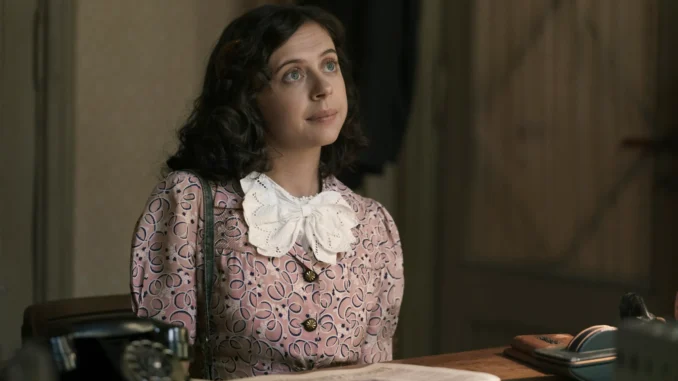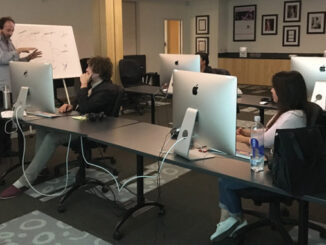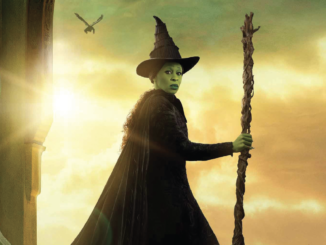
By Trevor Hogg
Driven by a natural curiosity, Susan E. Kim started out making experimental films that would combine random elements, such as X-ray footage of sword swallowers. That helped teach her the power editing has in shaping the narrative.
Good fortune led to the ACE Diversity Mentorship Program, where editors Nena Erb, Nona Khodai and Chris Cooke provided guidance. Kim worked as an assistant editor for Harry Yoon and Melissa Kent. In 2021, she became a Sally Menke Editing Fellow at Sundance and was mentored by Dody Dorn and Affonso Gonçalves, with the latter teaching her the benefits that editors can get from having a genuine curiosity about everything.
Her editorial journey has consisted of short films, feature films and TV series such as “Conflation,” “Two Yellow Lines,” “Pachinko,” “Little America” and, most recently, “A Small Light,” an acclaimed National Geographic miniseries about Miep Gies, a Dutch woman who helped the family of Anne Frank hide from the Nazis during World War II.
CineMontage: When did you first become aware of Anne Frank and did working on A Small Light change your perspective in regards to her story?
Susan E. Kim: I had read Anne Frank’s diary in junior high but had forgotten so much and actually had no memory of Miep Gies’ role. When I read the pilot script, I was struck by how important it is that we understand the story is still relevant today. Look at the things happening in the world and the rise in anti-Semitism. The show asks what it means to be an ally to those who are being violently targeted and how we can all do better. It also made me reflect on my elderly Asian American parents. It was a scary time during the pandemic and I worried for their safety. Could they walk down the street or would they be the target of violence, just for being who they are? Who would be the Miep who’d stand up for them? Knowing that the show asks these important questions motivated me to work on it. Not only that, there’s a message of hope. Miep showed us what one brave woman was willing to risk, in order to do the right thing.
CineMontage: What sorts of research did you conduct?
Susan E. Kim: I like to watch prior work by the showrunners [Tony Phelan, Joan Rater] and the directors [Susanna Fogel, Tony Phelan, Leslie Hope]. I also read the scripts, ideally a few times before production starts; that way you can flag any questions you might have early. I especially studied spy-thriller-action sequences. You know, scenes where you wonder how people are going to get out of extreme situations. I was interested in understanding what makes something suspenseful, certain timings or details, seeing the choices in cutting patterns. I’ve never been to Amsterdam, so I wanted to see photos and videos to get a sense of what it might have sounded like. If I know who the composer is, I’ll listen to everything they’ve done. Ariel Marx, our wonderful composer, came on board early, so I got to know her work before I started cutting. My favorite thing is to read the scripts while listening to the composer’s music. It really gets me in the mood!
CineMontage: What were some of the conversations that you had with Susanna Fogel and Tony Phelan when editing episodes 101, 103 and 106?
Susan E. Kim: Instead of being visually dark and dour, Tony was aiming for this vibrant palate and he had exciting ideas for music as well. The idea to use something in the realm of Tin Hat Trio was floated early and I’m so happy that the needle drop that I used for the jam-making sequence in the pilot made it to the final aired version. It felt unexpected but also had the right energy and was a nice compliment to Ariel’s gorgeous score. Plus, the song left space for some sweet ASMR jam-making sound design. Susanna encouraged me to look out for “weird” choices from the actors. This was permission to stay open-minded to things that might feel unconventional, while ringing of truth. We’re not so polished as humans, sometimes we’re a little off and messy. Without ever compromising their craft, Bel Powley and Joe Cole offered so many moments of this complexity, in their believability and realness, in their unexpected choices that kept me on the edge of my seat.

CineMontage: How much did the true story aspect weigh up the editorial decision-making?
Susan E. Kim: Tony and Joan had been living with this project for many years. Everything was meticulously researched and thought-out. By the time we were editing the show, we could focus on the usual questions of pace, clarity and performance, instead of, say, fixing historical inaccuracies. I always wanted to make sure that the editing choices worked in a way that honored the reality of what was happening in the story. One of the unique aspects of the show is that we’re following people in privilege. Our heroes are not in hiding, they’re out in the world. There’s a balance in acknowledging the horrors of what’s happening and the freedom that Miep and Jan and others had. There’s a moment when Miep, Jan and Mr. Van Pels are walking to the Frank’s house. Van Pels tells a Nazi officer, under his breath, to “go shit in an ocean.” Bel offered a couple takes in response to this, with a visceral laugh. On the one hand, it was a bold choice that underscored the tension. However, her laugh moved the needle a little too far in a lighter direction, so I ended up using a take without the laugh. It kept us inside the urgency and tension.
CineMontage: How hard was it to get the proper pacing and tone to create the impression of history unfolding rather being recreated?
Susan E. Kim: In the pilot we experimented with structure. Originally, the script moved between past and present – the past being Miep’s backstory and the present being the bike ride that Miep and Margot make to get to the hiding place. Joan asked me to try combining all of the past and to also build a new scene. I had to figure out a way to use existing footage so that Miep and Margot can have a more of prolonged conversation at the checkpoint bridge. This is the scene that also triggers Miep’s backstory. I was able to reappropriate pieces of footage to construct this. We also wrote some new ADR for Miep and Margot to help everything connect. It’s always a huge challenge to do this kind of a rewrite in the edit. Luckily, it worked and Joan and Tony liked what I put together.
CineMontage; What made the fight between Miep and Jan in the pilot a complicated scene?
Susan E. Kim: On the technical side, they’re taking off layers of clothing and we ended up making lifts throughout. It took some work to move them through their action and also build and calibrate the intensity of their fight. Because the camera wasn’t locked down, there was no split screen manipulation I could lean on, even if I wanted to. On the dramatic side, this scene was complex because of the spectrum of emotional ground that’s covered. I can’t remember the last time I’ve seen a fight between a couple that feels as charged and real as this.
CineMontage: Is there a particular shot or sequence that you are looking forward to people seeing?
Susan E. Kim: In Episode 106, Jan has to figure out how to get a group of people out of the city. By design, it’s intercut with Miep going through her own intense journey. The episode is called “Boiling Point,” by the way. Building an arc across the episode required that things kept ramping up and up and up. I still get stressed out when I watch it because of the tension. What makes suspenseful action work is that it’s grounded in this understanding of personal risk, of people helping the most vulnerable. We, as an audience, understand the stakes and really care about everyone involved. I’m super-proud of what we accomplished.
Trevor Hogg is a freelance writer.





